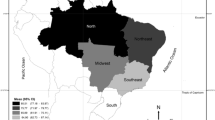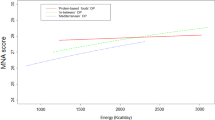Abstract
The elderly are at nutritional risk as a result of multiple physiological, social, psychological, and economic factors. Physiological functions naturally decline with age, which may influence absorption and metabolism. Social and economic conditions can adversely affect dietary choices and eating patterns. However, at the same time, the nutrient needs of the elderly for certain nutrient (such as vitamins, minerals, proteins) is higher than for younger adults. This article reviews the importance of zinc (Zn) in elderly people, particularly for behavioural and mental function, micronutrient status, immune and antioxidant system, and bone metabolism.
Sponsorship:
The ZENITH Study is supported by the European Commission ‘Quality of Life and Management of Living Resources’ Fifth Framework Program, Contract No: QLK1-CT-2001-00168.
This is a preview of subscription content, access via your institution
Access options
Subscribe to this journal
Receive 12 print issues and online access
$259.00 per year
only $21.58 per issue
Buy this article
- Purchase on Springer Link
- Instant access to full article PDF
Prices may be subject to local taxes which are calculated during checkout
Similar content being viewed by others
References
Abdallah SM & Samman S (1993): The effect of increasing dietary zinc on the activity of superoxyde dismutase and zinc concentration in erythrocytes of healthy female subjects. Eur. J. Clin. Nutr. 47, 327–332.
Abiaka C, Olusi S & AL-Awadhi A (2003): Serum microminerals and the indices of lipid metabolism in an apparently healthy population. J. Clin. Lab. Anal. 17, 61–65.
Allen KG & Klevay LM (1978): Copper deficiency and cholesterol metabolism in the rat. Artherosclerosis 31, 259–271.
Angus RM, Sambrook PN, Pocock NA & Eisman JA (1988): Dietary intake and bone mineral density. Bone Miner. 4, 265–277.
Bannon DI, Abounader R, Lees PSJ & Bressler JP (2003): Effect of DMT1 knockdown on iron, cadmium, and lead uptake in Caco-2 cells. Am. J. Physiol. 284, C44–C50.
Bettger WJ (1993): Zinc and selenium, site specific vs general antioxidant. Can. J. Physiol. Pharmacol. 71, 721–724.
Blumberg J (1997): Nutritional needs of seniors. J. Am. Col. Nutr. 16, 517–523.
Bunk MJ, Dnistrian AM, Schwartz MK & Rivlin RS (1989): Dietary Zn deficiency decreases plasma concentrations of vitamin E. Proc. Soc. Exp. Biol. Med. 190, 379–384.
Chandra RK (1984): Excessive intake of Zn impairs immune responses. JAMA 252, 1443–1446.
Dardenne M (2003): Zinc and immune function. Eur. J. Clin. Nutr. 56, S20–S23.
Disilvestro R & Cousins R (1983): Physiological ligands for copper and Zn. Ann. Rev. Nutr. 3, 261–288.
Eberle J, Schindmayer S, Erben RG, Stangassinger M & Roth HP (1999): Skeletal effects of zinc deficiency in growing rats. J. Trace Elem. Med. Biol. 13, 21–26.
Fairweather-Tait SJ (1988): Zn in human nutrition. Nutr. Res. Rev. 1, 23–37.
Frederickson Ch J, Won Suh S, Silva D, Frederickson CJ & Thompson RB (2000): Importance of Zn in the central nervous system: the Zn-containing neuron. J. Nutr. 130, 1471S–1483S.
Gaither LA & Eide DJ (2001): The human ZIP1 transporter mediates Zn uptake in human K562 erythroleukemia cells. J. Biol. Chem. 276, 22258–22264.
Girondon F, Galan P, Monget AL, Boutron-Ruault MC, Brunet-Lecomte P, Preziosi P, Arnaud J, Manguerra JC & Herchberg S (1999): Impact of trace elements and vitamin supplementation on immunity and infections in institutionalized elderly patients: a randomized controlled trial. Arch. Intern. Med. 159, 748–754.
Gunshin H, Mackenzie B, Berger UV, Gunshin Y, Romero MF, Boron WF, Nussberger S, Gollan JL & Hediger MA (1997): Cloning and characterization of a mammalian proton-coupled metal-ion transporter. Nature 388, 482–488.
Gur A, Colpan L, Nas K, Cevik R, Sarac J, Erdogan F & Duz MZ (2002): The role of trace minerals in the pathogenesis of postmenopausal osteoporosis and a new effect of calcitonin. J. Bone Miner. Metab. 20, 39–43.
Harrison NL & Gibbsons SJ (1994): Zn2+: an endogenous modulator of ligand- and voltage-gated ion channels. Neuropharmacology 33, 935–952.
Heaney RP (1986): Calcium bone health and osteoporosis. In Bone Miner. Res. ed WA Peck, vol. 4, pp 255–301. New York: Elsevier.
Ibs KH & Rink L (2003): Zinc-altered immune function. J. Nutr. 133, 1452S–1456S.
Killcross S (2000): The Amygdala, emotion and learning. Psychologist 13, 502–507.
Kishi S & Yamaguchi M (1994): Inhibitory effect of zinc compounds on osteoclast-like cell formation in mouse marrow cultures. Biochem. Pharmacol. 48, 1225–1230.
Klevay L, Pond W & Medeios D (1994): Decreased high-density lipoprotein cholesterol and apoprotein A-1 in plasma and ultrastructural pathology in cardiac muscle of young pigs fed a diet high in zinc. Nutr. Res. 14, 1227–1239.
Klotz LO, Kröncke KD, Buchczyk DP & Sies H (2003): Role of copper, zinc, selenium and Tellurium in the cellular defense against oxidative and nitrosative stress. J. Nutr. 133, 1448S–1451S.
Lewenson CW (2003): Zn regulation of food intake: new insights on the role of neuropeptide Y. Nutr. Rev. 61, 247–249.
Li YV, Hough CJ, Suh SW, Silva D, Sarvey JM & Frederickson CJ (2001): Rapid translocation of Zn2+ from presynaptic terminals into postsynaptic hippocampal neurons after physiological stimulation. J. Neurophysiol. 86, 2597–2604.
Little KY, Castellanos X, Humphries LL & Austin J (1989): Altered Zn metabolism in mood disordered patients. Biol. Psych. 26, 646–648.
Lowe NM, Fraser WD & Jackson MJ (2002): Is there a potential therapeutic value of copper and zinc for osteoporosis? Proc. Nutr. Soc. 61, 181–185.
Maes M, D’Haese PC, Scharpe S, D’Hondt PD, Cosyns P & De Broe ME (1994): Hypozincemia in depression. J. Affect. Disorders 31, 135–140.
Markovits PM, Sankey AW, James DK, McCabe R, Mahomed K & Golding J (1990): Zn taste test and postnatal depression. Br. J. Psych. 156, 451–452.
Mc Loughlin IJ & Hodge JS (1990): Zn in depressive disorder. Acta Psychiatr. Scand. 82, 451–453.
Mejia LA (1986): Vitamin A-nutrient interrelationships. In Nutrition Basics and Applied Science – A Series of Monographs ed JC Bauernfeind, pp 89–100. New York: Academic Press Inc.
Nowak G & Szewczyk B (2002): Mechanisms contributing to antidepressant Zn actions. Pol. J. Pharmacol. 54, 587–592.
O’Brien KO, Zavaleta N, Caulfield LE, Wen J & Abrams SA (2000): Prenatal iron supplements impair Zn absorption in pregnant Peruvian women. J. Nutr. 130, 2251–2255.
Ortega RM, Requejo AM, Andres P, LopezSobaler AM, Quintas ME, Redondo MR, Navia B & Rivas T (1997): Dietary intake and cognitive function in a group of elderly people. Am. J. Clin. Nutr. 66, 803–809.
Powell SR (2000): The antioxidant properties of zinc. J. Nutr. 130, 1447S–1454S.
Prasad AS (2000): Effects of zinc deficiency on immune function. J. Trace Elem. Exp. Med. 13, 1–20.
Prasad AS, Fitzgerald JT, Hess JW, Kaplan J, Pelen F & Dardenne M (1993): Zinc deficiency in elderly patients. Nutrition 9, 218–224.
Shankar AH & Prasad AS (1998): Zn and immune function: the biological basis of altered resistance to infection. Am. J. Clin. Nutr. 68, 447S–463S.
Singh RB, Niaz MA, Rastogi SS, Bajaj S, Gaoli Z & Shoumin Z (1998): Current zinc intake and risk of diabetes and coronary artery disease and factors associated with insulin resistance in rural and urban populations of North India. J. Am. Coll. Nutr. 17, 564–570.
Solomons NW (1986): Competitive interaction of iron and Zn in the diet: consequences for human nutrition. J. Nutr. 116, 927–935.
Su JC & Birmingham CL (2002): Zn supplementation in the treatment of anorexia nervosa. Eat. Weight Disord. 7, 20–22.
Takeda A, Takefuta S, Okada S & Oku N (2000): Relationship between brain zinc and transient learning impairment of adult rats fed zinc-deficient diet. Brain Res. 859, 352–357.
Thomson ABR & Keelan M (1986): The aging gut. Can. J. Physiol. Pharmacol. 64, 30–38.
Thorsell A & Heilig M (2002): Diverse functions of neuropeptide Y revealed using genetically modified animals. Neuropeptides 36, 182–193.
Yamaguchi M (1998): Role of zinc in bone formation and bone resorption. J. Trace Elem. Exp. Med. 11, 119–135.
Acknowledgements
The authors thank Nathalie Boirie for improving English.
Author information
Authors and Affiliations
Corresponding author
Additional information
Guarantor: C Coudray.
Contributors: NM and CC wrote the paper; JMO, GM, AMR are the centre coordinators of the zenith study. All authors read and contributed to finalization of the manuscript.
Rights and permissions
About this article
Cite this article
Meunier, N., O'Connor, J., Maiani, G. et al. Importance of zinc in the elderly: the ZENITH study. Eur J Clin Nutr 59 (Suppl 2), S1–S4 (2005). https://doi.org/10.1038/sj.ejcn.1602286
Published:
Issue Date:
DOI: https://doi.org/10.1038/sj.ejcn.1602286
Keywords
This article is cited by
-
Exploring the potential function of trace elements in human health: a therapeutic perspective
Molecular and Cellular Biochemistry (2023)
-
Fashionable Co-operative Sensing of Bivalent Zn2+ and Cd2+ in Attendance of OAc− by Use of Simple Sensor: Exploration of Molecular Logic Gate and Docking Studies
Journal of Fluorescence (2022)
-
Bone metabolism in response to oat bran consumption and jogging exercise in young males
Sport Sciences for Health (2018)
-
Trace Mineral Micronutrients and Chronic Periodontitis—a Review
Biological Trace Element Research (2017)
-
Mitigating zinc deficiency and achieving high grain Zn in rice through integration of soil chemistry and plant physiology research
Plant and Soil (2012)



